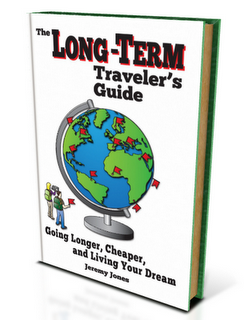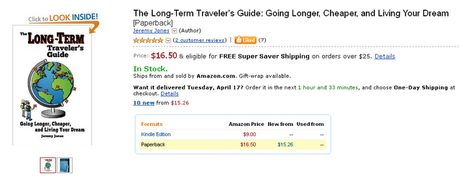 During our time putting together our first self-published travel book, The Long-Term Traveler's Guide,
we had to spend a lot of time learning about the self-publishing
process and the travel book industry in general. In order to save
future author's time and money, this ten-part Writing a Travel Book series was born!
During our time putting together our first self-published travel book, The Long-Term Traveler's Guide,
we had to spend a lot of time learning about the self-publishing
process and the travel book industry in general. In order to save
future author's time and money, this ten-part Writing a Travel Book series was born! The following is a quick list of the entries into this special feature. To learn more about our book launch and other information associated, please check out the Travel Book sidebar on this site.
Part 1 - Finding a Niche and Writing
Part 2 - Editing and Formatting
Part 3 - Evolution of a Cover Design
Part 4 - Digital Packages and Special Features
Part 5 - Developing a Website for Sales
Part 6 - Distribution Companies
Part 7 - Pricing Development and Launch
Part 8 - Affiliate Sales Programs and Tips to Succeed
Part 9 - The Cost of Writing and Sales Summary
Part 10 - Final Thoughts
Writing a Travel Book Part 7 - Pricing Development and Launch
After several months or years writing a book, formatting the layout, designing a cover, building a website, and getting the product ready for launch, there is only one major detail left to consider: cost.
For something that takes such a sizable chunk of your life, determining the optimal price to sell your product could be a very hard decision. Price the product too high and there will be no interest. Price it too low and you will have to sell more products to make an appreciable profit and cover your costs. Factor in affiliate commissions (Part 8 of this series) and your take home payment may be even less.
For The Long-Term Traveler's Guide, we had a relatively easy time pricing the printed book as many 250 page guidebooks are within the $15 to $20 range. At $16.50 we think the book is just right for what we provide without being too high that it is a turn-off. For a comparable Kindle and Nook format, most books fall within the $6-$10 range for which we chose the $9 price point to fit right in with market standards. In an effort for full disclosure, for both the print and reader formats of the guide, we receive roughly $6 in profit per sale and was part of the reason we chose these price points. For the digital package, we did not get off so easy and had to explore several avenues to determine what the optimal price should be.
Look to Other Products for Advice

The great thing about selling products digitally is that you have easy access to pricing for all other comparable products that are currently for sale. In the travel market it only takes a few Google searches to not only find pricing for other travel products, but also know everything about what is included and reviews to see if it is popular. The downside is that everyone else can find out this information as well and can quickly search to see if your product is a good value compared to several others.
Unfortunately for our launch, research into pricing of other reputable travel products range anywhere from $5 for a simple e-book to $75+ for a comprehensive package! With such a wide range, we found it was necessary to take a more focused look on what each type of product offers to see why the pricing was warranted.
Products on the high end of this range are advertised to make you an expert on several topics and to aid in generating revenue through a website. Products on the low end are typically a 50 to 100 page presentation designed to educate you on a singular topic within the travel universe. Prices somewhere in the middle typically offer personal communications with the owner or private forums for advice not provided within the package.
As with all digital products, especially around the topic of books, the costs associated with printing and shipping a tangible good are removed. The $10 fee for a printed book reduces to the same $3 fee as its Kindle and Nook counterparts. In order to sell your product for a premium, the package should include a significant amount of bonus features that could not be featured in the printed format. If you do not offer these extras with your digital package, the only direction your online pricing should go is down.
As our product includes several features that could each be sold in the $5 range, a personal communications feature for our travel advice, and a digital copy of the book, we began our pricing research right in the middle of this common range to see what would stick. To validate, we had to get other traveler's opinions.
Ask For Community Advice
In your preparation for launch, it is highly likely that you have given your product to several others in the industry to generate interest and have published reviews on launch day. If this is the case, don't let the owners of the sneak preview copies off without giving their input! The best way to obtain pricing for your product is to find out what those who could benefit from it would be willing to pay. Float some numbers by the owners of your pre-release copies and see what they think.
As we came to find with the digital package of The Long-Term Traveler's Guide, the best price is slightly low, if not just right for many who had hands-on time with the sneak preview copy. At $25 the digital package is a slight premium over its $16.50 printed counterpart, yet low enough that it would not require any traveler to give up a whole day exploring the world to purchase it. This mental block is one we made sure not to cross, and the responses we got from the community reinforced our pricing considerably!
"I think your pricing is great, especially with the extras that you are offering for the digital package. I'm pretty sure that I would have forked over $25 for that much help when I was researching/planning." - A long-term traveler who contributed to the guide.
"Personally I would pay more than what you are selling the package for, no question!" - A fan who is currently planning their own long-term trip.
If you get responses like these, then you know you are on the right track. Resist the urge to charge more, as you may ultimately price yourself out of the value your product brings. When it comes down to it, having to sell one or two more copies to make up for a small price difference is a small hurdle if your product is good enough to sell. Once you settle on pricing, you are ready for launch!
A side bonus to having reviewers give their input on pricing is that this detail will show up in their review. An excited reviewer who likes your pricing will most certainly show their feelings in their critique. Remember, the kiss-of-death in a review of your product is a complaint that the pricing is too high. Let your reviewers work for you and take their input to heart.
Building Up to Launch
In the days leading up to launch, you may be so excited that some of the minor launch details are overlooked. Be sure to check off the following items to ensure your launch day goes as smooth as possible:
- Get your product's website listed on Google and other search engines.
- Make sure all ordering links are live, working, and available for customers.
- Organize reviews and promotional activities from your peers.
- Schedule interviews with other authorities in your industry.
- Publish teaser information or posts on your websites, social networks, or other online hangouts.
- Distribute complimentary copies to those in the industry to generate more reviews over the coming weeks and months. They may take significantly longer than you would like, so get them their copies as early as possible.
But with all things, don't let this happen on just launch day. Keep at it! The more you promote, the more sales you will have. A book deal, if that is your goal, will not come on launch. Most self-publishers who have received a book deal will admit that it took thousands of tweets and countless hours of promotion before being noticed. Spikes in sales often coincide with a major authority giving a mention, review, or interview. Neither of these will likely happen on Day 1, so you must keep at it if you want your product to be a success. If you do not believe in what you are selling enough to promote it continually, then no one will believe it is worth buying and will be reflected in your sales. Do not give up, the real work is just beginning!
-----------------------------------------------------------
This ten part feature on writing and self-publishing a travel book is based on our experiences with our first book, The Long-Term Traveler's Guide, and is provided free of charge for those looking to write a book or e-book themselves. Other authors typically charge a modest price for an e-book that contains this information in such a fashion. Rather than requiring a purchase for this information, if you like what you have read please Reweet, Stumble, or 'Like' this post, use our affiliate links when registering for the companies we've recommended, or purchase a copy of The Long-Term Traveler's Guide to help us out!
Thank you for your support and happy travels!
